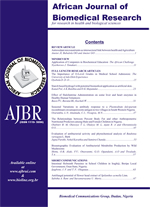
|
African Journal of Biomedical Research
Ibadan Biomedical Communications Group
ISSN: 1119-5096
Vol. 20, No. 3, 2017, pp. 245-247
|
 Bioline Code: md17036
Bioline Code: md17036
Full paper language: English
Document type: Short Communication
Document available free of charge
|
|
|
African Journal of Biomedical Research, Vol. 20, No. 3, 2017, pp. 245-247
| en |
Prevalence of Malaria Parasitaemia among Children Resident in Orphanages in Anambra State, Nigeria
Oluboyo, B.O.; Enweani, I.B.; Ekejindu, I.M. & Oluboyo, A.O.
Abstract
Malaria parasitemia in Anambra State and in Nigeria at large is of public health significance. Determination of malaria parasite density is helpful in disease monitoring and assessment of drug efficacy. This study investigated the prevalence of malaria parasitemia among children resident in orphanages located in Anambra State, Nigeria and related the malaria parasite density gotten from actual WBC count with value got using World Health Organization (WHO) assumed mean. A total of 272 subjects comprising 172 orphans and 100 children in family setting (controls) were investigated for malaria parasitemia using Giemsa stain. Malaria parasite density was carried out according to WHO recommendation. A prevalence of 23.3% and 12.0% malaria parasitemia were observed for children in orphanage and family setting respectively (p<0.05). The disease significantly affected the children in all the age ranges with children in ages 0-5 most affected (p<0.05). The mean malaria parasite density measured based on WHO assumed WBC mean value was significantly higher than using the actual WBC count (p˂0.05). The use of total WBC count reference value for a given locality in measuring malaria parasite density is recommended rather than an assumed value.
Keywords
Prevalence; Malaria Parasitaemia; Orphanage; Parasite Density
|
| |
© Copyright 2017 - African Journal of Biomedical Research
|
|
